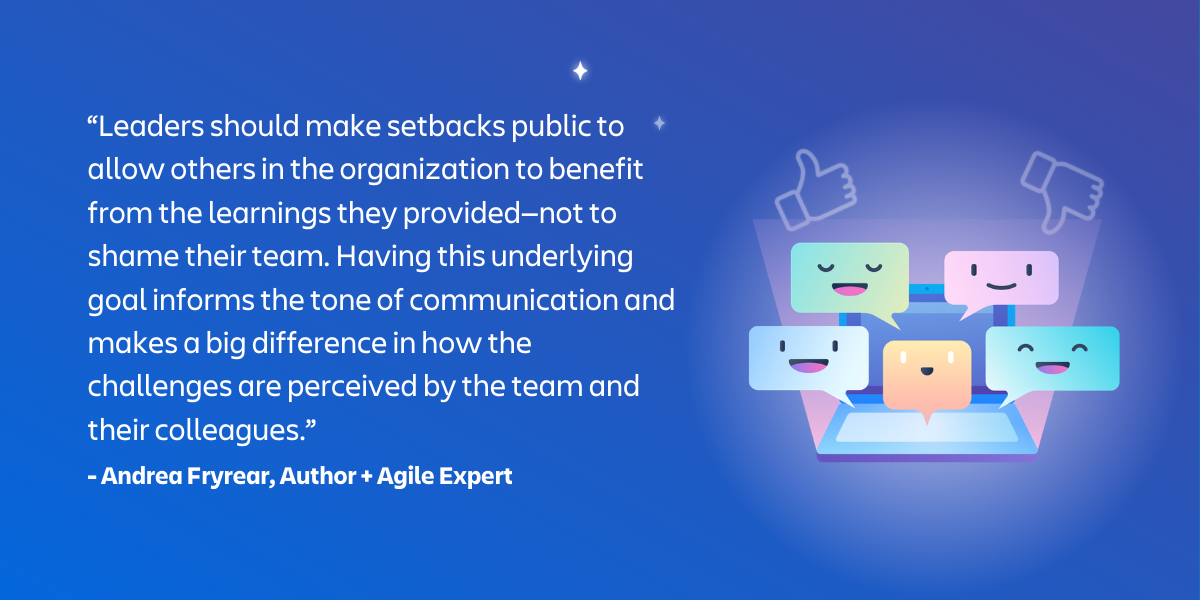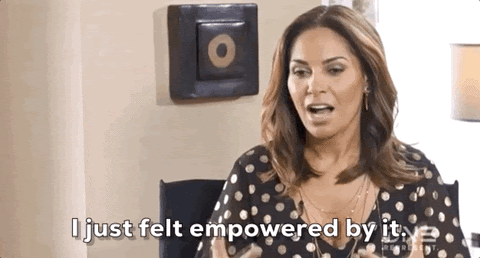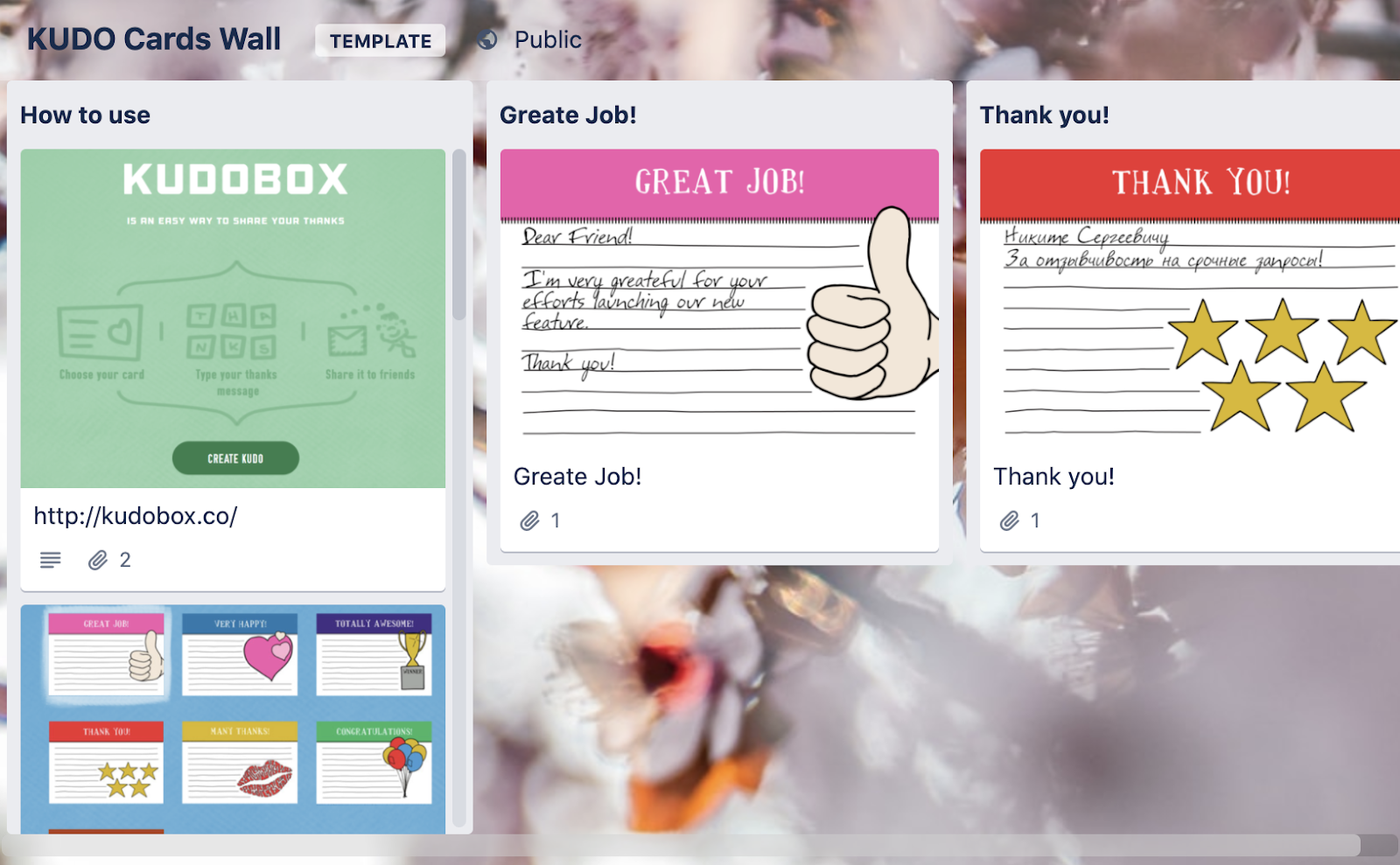Agile is all about optimizing performance. Whether it’s checking in on progress during a daily stand up meeting, powering through a sprint, or taking time to reflect and readjust at a retrospective, the entire agile framework is designed to drive continuous improvement.
One way to inspire that improvement and help teams grow in the process is by celebrating wins and failures.
Celebrating wins (bravos) and identifying failures, challenges, or setbacks (woes) are integral parts of the agile process. But what makes woes and bravos such a crucial part of agile? How should they be celebrated? And what steps can you take to ensure these moments of celebration and reflection become a go-to part of your agile process—and inspire the best from your team in the process?
We asked these three agile experts for their insights on why and how teams can celebrate woes and bravos within the agile framework:
- Andrea Fryrear, co-writer of the ICAgile Certified Professional in Agile Marketing curriculum and author of Mastering Marketing Agility: Transform Your Marketing Teams and Evolve Your Organization
- Niall McShane, leadership coach, change management consultant, and author of the upcoming Responsive Agile Coaching: How to Accelerate YourCoaching Outcomes with Meaningful Conversations
- Colleen Johnson, co-founder and CEO of agile retrospective software ScatterSpoke
Here’s what they had to say:
Why Is Celebrating Woes And Bravos So Important?
First things first—before we jump into how to celebrate woes and bravos agile-style, let’s talk about why identifying woes and bravos is so important to the success and health of your team.
Let’s start with the fun stuff—why is celebrating wins, or bravos, so key?
“Wins are important for two reasons: one, they help keep the team’s morale up, even in the midst of rapid execution…[which] is vital in an agile environment, because teams are moving quickly from one project or sprint to another,” says Fryrear.
“Without retrospectives and deliberate celebrations, it can feel like constant joyless motion. That’s certainly not the vibe that creates a high-performing team.”
“Two, they provide an opportunity to identify successful experiments that should become candidates for future iterations,” continues Fryrear. “A success may indicate an unexpected win or positive result on a new experiment, which the team might want to pour more effort into in the future. Without celebration, these bright spots might pass unnoticed and unexploited.”
So, celebrating bravos not only boosts team morale, but it also helps the team identify what’s working and what they should continue.
And identifying woes is important for the opposite reason; it allows teams to identify what’s not working—both on an individual or team level and with the actual work the team is producing—and make the necessary changes to improve moving forward
“It’s almost always the negative feedback that allows us to improve; that’s just as true for process improvement as it is for creative work,” says Fryrear. “Nothing is ever 100% perfect, and pretending like it is hides opportunities for optimization.”

How To Effectively Celebrate Wins And Identify Failures Within The Agile Framework (And Beyond)
Clearly, celebrating wins and losses is a must for successful agile teams. But woes and bravos aren’t agile exclusive; you can reap the benefits regardless of whether your team is familiar with agile processes or not.
So, the question is, how can you incorporate woes and bravos into your business processes,—and make sure you’re celebrating successes and acknowledging challenges in a way that improves your processes, your team, and your productivity?
1. Create A Safe Space For Feedback
You can’t make woes and bravos a part of your team’s culture if they don’t feel comfortable sharing feedback—which is why the first step of incorporating woes and bravos into agile is creating the kind of environment where feedback of all types is welcomed and encouraged.
“Agile is about building a high-performing team with a sustainable culture,” says McShane. “[And a big part of that is] this ability for a team to be vulnerable with each other without fear of repercussion.”
Whether your team feels comfortable with that vulnerability comes down to a concept called psychological safety, which allows team members to take risks and make mistakes without the fear of being punished, shamed, or ostracized. A two-year study from Google found that psychological safety is a key element of high performing teams—and creating that sense of safety is a must if you want to roll out woes and bravos to your team (and reap the benefits in the process).
There are a few different ways you can create psychological safety within your team, including:
- Ask for feedback—and accept it gracefully. At the core, woes and bravos are types of feedback. And if you want your team to feel safe to give and receive feedback openly, lead by example. Ask for feedback, accept it gracefully, and use it to grow—even if that feedback is tough to hear.
- Banish blame. If something goes wrong on your team, don’t use it as an opportunity to point fingers. If team members are worried they’re going to get called out or reprimanded if they make a mistake, they’re going to be less likely to take risks. Instead, reframe “mistakes” as learning opportunities, and let your team know that your approach isn’t “mistakes are tolerated”—it’s “learning opportunities are celebrated.”
- Identify any threats to psychological safety and deal with them immediately. It only takes one person to create a hostile, unsafe environment for the rest of the team. If you have an employee or leader that’s threatening the sense of psychological safety on the team (for example, by yelling at or demeaning people when they make mistakes), it’s important to address the issue immediately—and if it doesn’t get better, think about removing the person from the team.
2. Put It On The Calendar And Celebrate Regularly
Whether you’re celebrating a huge win or addressing a major setback, the key to woes and bravos? Celebrating them often.

“The more time that passes, the harder it is to remember what’s happening,” says Johnson. That’s why you want to make celebrating woes and bravos a regular part of your agile process.
But the question is, how regular a part of your process should these celebrations be?
While you can certainly incorporate woes and bravos into your daily stand ups, because stand ups are so short, you’re not going to have the time to really dig into the wins or challenges. So, make sure to set aside more deliberate time for woes and bravos during retrospectives every few weeks.
“I recommend three weeks as the maximum time between these types of retrospectives,” says Fryrear. “Any longer and people start to forget the realities of the situation, and you get vague recollections instead of actionable insights.”
If your team hasn’t been working together for that long, you may want to schedule more frequent meetings for woes and bravos. Since newer teams are still finding their groove, meeting on a more regular basis to celebrate wins and identify areas for improvement can help them get up to speed more quickly.
“Newer agile teams often benefit from even more frequent touchpoints,” says Fryrear. “Celebrations every week can greatly improve the continuous improvement metabolism of a new team.”
3. Be Proud Of Achievements And Celebrate Publicly
So, you’ve started celebrating woes and bravos with your team—chefs kisses to you! But to really make the most out of the process you should also plan to extend those celebrations to the rest of your organization—and that’s true for both wins and challenges.
Sharing wins with other teams, colleagues, and co-workers gives your team an opportunity to shine on a bigger stage, which can increase morale and get your team the recognition (and, potentially, the resources) they deserve.
Johnson recommends a public “kudos” board, where the entire organization can post personal wins or call out team members for their successes, support, or hard work.
“[The kudos board] can be a really cool visual for the team and for the organization to have everybody posting those appreciations, so other people outside the team can see it,” says Johnson.
✨ Pro-Tp: In addition to Trello, a Slack channel works wonderfully for public celebrations.
Celebrating wins publicly is easy—but sharing challenges, failures, or setbacks can feel more difficult.
But just because it feels difficult doesn’t mean it’s not beneficial. While you never want to “call out” anyone on your team or embarrass them in front of their coworkers, sharing your challenges with the rest of your company can help transform an individual or team learning opportunity into a learning opportunity for the entire organization.
“Leaders should make setbacks public to allow others in the organization to benefit from the learnings they provided—not to shame their team,” says Fryrear. “Having this underlying goal informs the tone of communication and makes a big difference in how the challenges are perceived by the team and their colleagues.”

4. Listen To What Your Team Needs
Addressing woes isn’t about pointing the finger or finding someone to blame when things go wrong. Instead, it’s about listening to the challenges your team members are having and then finding ways to remove roadblocks that are stopping them from being successful.
“A good leader will be one that serves the team and gets things out of their way…as opposed to pushing the problem back to the team or using fear instead of solving the problem,” says McShane.
For example, if one of your team woes is that you missed a major deadline, ask deeper questions to figure out where the bottleneck happened—and then take any necessary steps to eliminate that bottleneck. For example, did your team run into issues communicating with other stakeholders?
Look into tools that enable better communication and collaboration between teams. Did your team struggle to solve a particular type of problem? See if there are any training opportunities to help better approach the problem in the future.
The point is, addressing woes isn’t about focusing on what your team did wrong; it’s about listening to what they need to do things right—and then delivering it.
5. Give Your Team Autonomy To Implement Changes
When you celebrate woes and bravos, you and your team should walk away with an actionable plan for how you want to change things moving forward. And if you want this practice to lead to growth within your team, you need to give them the autonomy to make those changes.

“What often comes out of retros and reviewing your wins and losses can be making changes to your process, and that’s a great thing to give the team ownership of,” says Johnson. “Then, they’re more invested in the process and they’re tailoring it to suit their needs over time.”
“All teams want to do is to be left alone to do the work and trusted that they can do it,” says McShane. “So, if a leader…trusts them and gives them what they need,” they’ll be empowered to make positive changes for themselves and their work—and the entire team (and organization) will benefit as a result.”
Using Trello To Celebrate And Track Wins And Failures
Woes and bravos can drive serious benefits for your team—if you want to get the most benefit driving bang for your buck, woes and bravos needs to become a core part of your process.
Using a Trello board as a space to celebrate your wins and acknowledge your challenges can help maximize the benefit that woes and bravos has on your team and organization. There are a few different ways you can use Trello to celebrate and recognize setbacks, including:
- Use Trello to record woes and bravos during stand ups and retros. When someone shares a woe or a bravo, you want to make sure you’re writing it down. That way, you can take any necessary next steps (like sharing a win with your organization’s higher ups or addressing an issue) and nothing falls through the cracks. With the Advanced Checklists feature, you can create a checklist of wins and failures—then add relevant members or deadlines to each item. If there are any action items, you can easily convert the checklist item into a card to add to any relevant Trello boards.
- Make a digital kudos board. Johnson recommended creating a kudos board to celebrate wins across your organization. But because so many companies are working remotely, a physical kudos board isn’t ideal. With Trello, you can create a digital kudos board where team members across your organization can create cards to celebrate wins and tag other team members to give them a shout out for a job well done.
- Use your Trello board to automate woes and bravos. As mentioned, in order to get the most benefit from woes and bravos, it needs to be a part of your regular business systems. With Trello’s Card Repeater Power-Up, you can automate the entire woes and bravos process. Just create a card (for example, a “Bravos Shout-Out” card), set it to repeat at a specific interval (for example, once per week), and then add relevant members, check lists, and due dates. Once you create the card, it will automatically repeat every week—and every member on the card will get a notification to share their shout out.

Celebrate Your Way To A More Collaborative Team
“Continuous improvement is vital for agile teams, and both woes and bravos should be part of the feedback loop that makes it possible,” says Fryrear. “By deliberately setting aside time to zero in on these pieces, the agile system runs better, produces stronger outcomes, and is more enjoyable for the people inside it.”
Your team is already awesome. But making woes and bravos a staple in your agile framework empowers your team to celebrate their successes, own their setbacks, and commit to continually growing, learning, and improving.
Next: How To Spot The Signs Of Team Overwhelm (And What To Do About It)








































